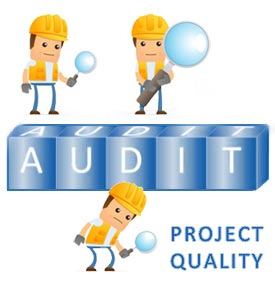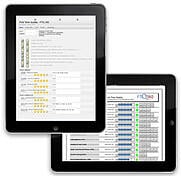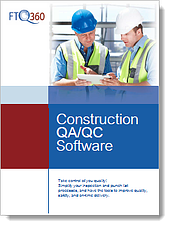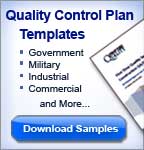 Your Project Quality Plan is in place. You think all contingencies are covered. You assume inspections are being conducted correctly. You figure your plan is being followed, your customer is happy, and your project is flowing smoothly, right?
Your Project Quality Plan is in place. You think all contingencies are covered. You assume inspections are being conducted correctly. You figure your plan is being followed, your customer is happy, and your project is flowing smoothly, right?
Not necessarily.
That’s why it’s important to conduct a project quality audit. Your audit will show you what’s working and what’s not — so that you can get your project quality on track.
What is a quality audit?
It's one of the basic elements of an effective quality control plan. A quality audit is a review of how well (if at all) the key areas of your project quality plan are being followed. And, whether it’s effective in getting you the quality results you expect.
It’s basically a fact-finding mission and should be part of your regular monthly routine.
How to conduct a quality audit
In general, you’ll be making field observations, talking to customers and project personnel, and reviewing QA/QC records and reports.
The audit doesn’t only cover your work. Since your quality plan covers all project participants such as subcontractors, suppliers, and other outside services, your audit should include them as well. Keep in mind, many sub-contractors and project owners conduct their own inspections, and they can give you important information for spotting quality issues.
8 Steps to follow to conduct your project quality audit
Here are the steps you should follow as you conduct your audit.
1. Talk to customers
It’s highly likely that your customers are performing their own inspections. Talk to them about their inspection results. Ask them to walk the jobsite with you to do a field quality review. If that’s not possible, you’ll still want to ask your customers a few questions such as:
- Are there any quality issues that they’ve found
- Are their expectations being met
2. Walk the jobsite – do your field quality review
You’re probably already walking the job site and observing the way workers do their jobs. For your audit, pay close attention to the following areas:
- Is their workmanship the quality you expect
- Are workers following the correct procedures
- Do they show that they have the skills needed to do the job
- If you’re dealing with lot controlled materials, do you see the lot identification markings
3. Review quality records and reports
Next, make a trip to the project field office and look at your project QA/QC documents and records. There are two reasons for this part of the audit. First, you want to see if your superintendents and project management personnel are completing and filing all the needed records and reports. Second, you want to check to see that they’ve completed them correctly.
4. Reinspect work tasks
Now, grab a few reports. It’s time to see if your inspectors have been doing a good job inspecting (aka inspector qualification). With your sampling of inspection and nonconformance reports in hand, go out and reinspect the work that’s already been inspected. Compare what you see on the report with your own observations.
- Is there anything they’ve missed
- Have the repairs and punch items been reported correctly
5. Talk to field personnel
The next step is to talk to your field personnel to see if they’re properly trained and following the correct procedures. You also want to learn about the standards, specifications, and drawings they’re using (or in some cases, not using).
A good way to conduct this part of the audit is to ask simple open-ended questions such as, “How do you know the right way to install an HVAC air handler?”
Here’s what you want to know:
- What training have they been given
- Do they have the necessary certifications if required
- Do workers have easy access to project standards, specifications, drawings, and change orders
- Are they using up-to-date standards and specs
6. Follow-up on previous audit action plan items
Follow up to see that progress is being made on previous audit action items. Each month, you should see improvements in your project quality and find fewer deficiencies.
7. Record your findings
Create an audit report and record your findings.
Keeping records will protect your company should future problems arise. It will demonstrate due diligence and your follow up will show that you’re making corrections to issues found.
8. Create an action plan
Finally, create your action plan. In order to figure out how to get better results, you’ll need to understand why your plan isn’t being followed fully. Maybe you need to reinforce the importance of following the plan. Could it be that your construction quality control plan is too complicated to follow? If your quality plan is being followed, are you getting the quality results you’d expected?
Once you know the issues, decide on a course of action and a plan to carry it out.
Conclusion
Auditing your project quality is an ongoing process. Whether you follow a formal, highly structured process or a more casual, less structured approach, you need to regularly audit the implementation and effectiveness of your project quality plan.
In time, all of your projects will get the quality results you expect — and with much less effort need from all project personnel.
About the Author - Ed Caldeira is founder of First Time Quality, LLC, specializing in submittal-ready project-specific quality plans as well as construction quality inspection and punchlist software.







